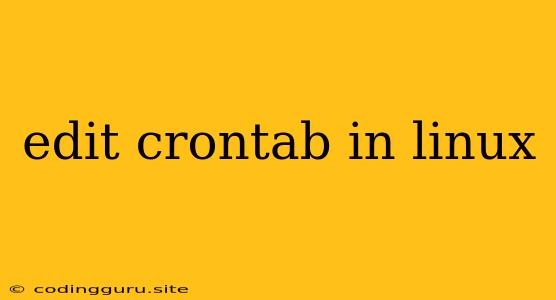How to Edit the crontab in Linux
The crontab is a powerful tool in Linux that allows you to schedule tasks to run automatically at specific times. Whether you want to backup your files, send email reminders, or perform other repetitive tasks, crontab makes it easy to automate these processes.
Understanding crontab
crontab is a command-line utility that allows users to define and edit cron jobs. It's essentially a text file that contains a series of commands and schedules. Each line in the crontab file represents a different job, with the following format:
* * * * * command to execute
Understanding Cron Expressions
The five asterisks in the crontab line represent cron expressions, which are used to define the schedule for the job. Here's a breakdown of each asterisk and its meaning:
- Minute: 0-59 (range of minutes in an hour)
- Hour: 0-23 (range of hours in a day)
- Day of Month: 1-31 (range of days in a month)
- Month: 1-12 (range of months in a year)
- Day of Week: 0-7 (Sunday is represented by 0 or 7, while Monday is 1, Tuesday is 2, and so on)
Example:
Let's say you want to run a script named backup.sh every day at 2 AM. Your crontab entry would look like this:
0 2 * * * /path/to/backup.sh
Editing crontab
There are several ways to edit the crontab file in Linux:
1. Using crontab -e:
This is the most common method. It opens the crontab file in your default text editor (usually vi or nano).
crontab -e
2. Using a Text Editor:
You can also edit the crontab file directly with a text editor like vim, nano, or gedit:
sudo crontab -l > /tmp/crontab
# Edit the file in your preferred editor
# Example using nano
sudo nano /tmp/crontab
# Replace the existing crontab file
sudo crontab /tmp/crontab
3. Using crontab -l and crontab -r:
To list the existing cron jobs:
crontab -l
To remove the existing cron jobs:
crontab -r
Tips for Editing crontab
- Use comments: Add comments using the
#symbol to explain the purpose of each cron job. This makes it easier to understand and maintain yourcrontabfile later on. - Use absolute paths: When specifying the command to execute, use absolute paths to avoid any issues with the current working directory.
- Test your jobs: Before you schedule a cron job to run regularly, test it manually to ensure that it works as expected.
- Use crontab -l to check your jobs: After making changes, use
crontab -lto verify that the changes have been applied correctly.
Troubleshooting
- Check the logs: If your cron job isn't running, check the system logs for any error messages. The log files you need to check will vary depending on your Linux distribution.
- Ensure the user has proper permissions: The user running the cron job must have the necessary permissions to execute the command.
- Check the PATH variable: Ensure the PATH environment variable includes the directory where the executable is located.
Example Crontab Entries:
# Run a backup script every day at 2 AM
0 2 * * * /path/to/backup.sh
# Send an email reminder every Friday at 10 AM
0 10 * * 5 mail -s "Weekly Reminder" [email protected] < reminder.txt
# Run a system update every Sunday at 3 AM
0 3 * * 0 apt update && apt upgrade -y
# Run a cleaning script every hour
0 * * * * /path/to/cleaning.sh
Conclusion
crontab is an indispensable tool for automating tasks in Linux. By understanding the syntax and using the tips provided above, you can effectively schedule your tasks and streamline your workflow. Remember to test your cron jobs thoroughly before scheduling them to run automatically.
